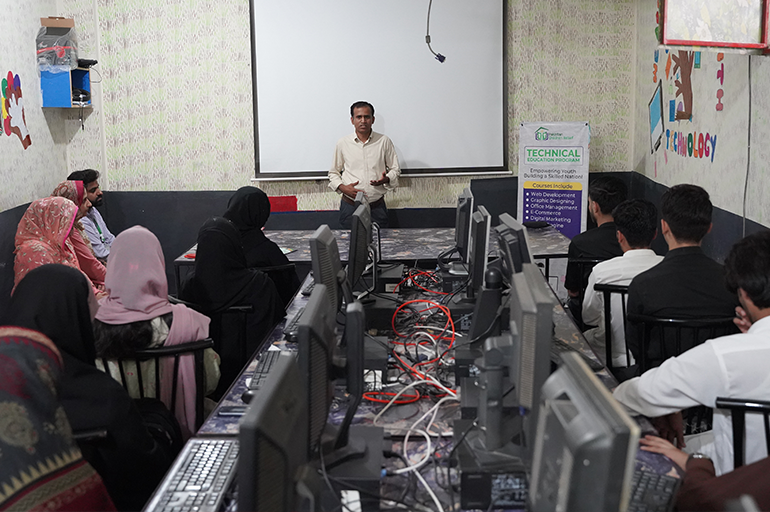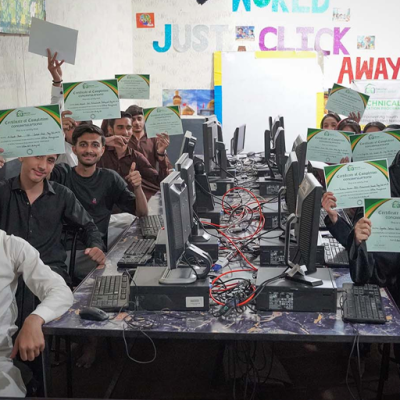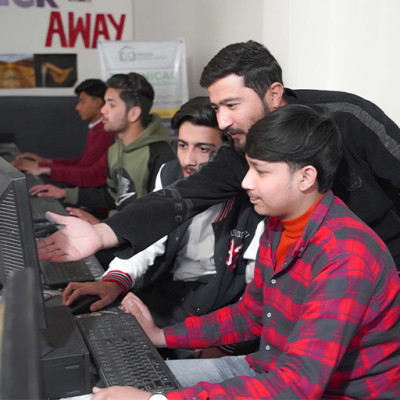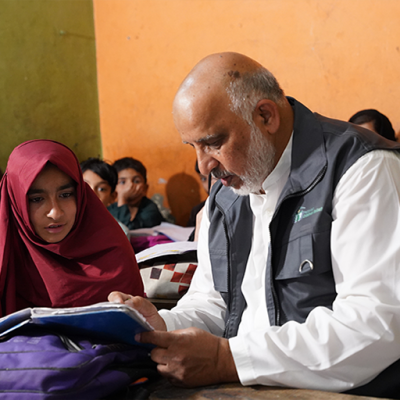In recent years, digital literacy has become a cornerstone of modern education, especially in rural regions of Pakistan where traditional learning systems often lag behind. As the world transitions into a technology-driven economy, the ability to use and understand digital tools is no longer optional it’s essential. In rural areas where educational resources are limited, improving digital literacy can empower students, enhance employability, and open pathways to new opportunities. Integrating technology into technical education programs in Pakistan is helping bridge the learning gap and create a more inclusive, skill-based education system.I
The Importance of Digital Literacy in Rural Education

Defining Digital Literacy
Digital literacy extends far beyond knowing how to use a computer it encompasses the ability to navigate digital platforms, analyze online information, and use technology for learning and problem-solving. In rural schools, these skills enable students to access a world of knowledge beyond textbooks, connecting them to global learning opportunities and digital communities.
Benefits of Digital Skills for Students
For students in rural areas, digital literacy can be life-changing. Access to online courses, virtual libraries, and interactive platforms allows them to learn subjects and skills not offered locally. These digital competencies also improve job prospects since nearly every modern career requires a degree of tech proficiency. In essence, digital skills empower rural youth to compete in a national and international workforce, breaking cycles of poverty and limited opportunity.
The Current State of Technical Education in Rural Pakistan
Overview of Existing Institutions
While rural Pakistan has a network of vocational and technical training centers, many are hindered by outdated facilities and limited technological resources. Classrooms often lack modern computers, reliable internet, or updated learning materials. This makes it difficult for instructors to teach skills relevant to today’s industries.
Curriculum Gaps and Limitations
The curriculum in most vocational training programs in Pakistan needs modernization. Many still rely on outdated manuals and tools that don’t reflect current job market needs. As a result, students graduate without the practical or digital skills required by employers. Revamping curricula to include technology-driven courses such as coding, digital marketing, and technical software use is crucial for bridging this gap.
Barriers to Digital Access for Rural Students
Lack of Infrastructure and Connectivity
Limited access to electricity, internet, and technological equipment poses one of the biggest challenges to rural digital education. Many schools in remote areas still lack computer labs or reliable power sources, leaving students disconnected from digital learning platforms.
Socioeconomic Barriers
Financial constraints are another major obstacle. For many rural families, purchasing a computer or paying for internet access remains unaffordable. When basic needs take priority, education—especially digital education becomes secondary. Bridging this divide requires collective effort through community-based support, public funding, and NGO initiatives.
Integrating Technology into Technical Education
Modern Teaching Approaches
To make learning more dynamic, educators must adopt hybrid models that combine traditional teaching with online learning. Interactive lessons, virtual workshops, and multimedia tools can enhance understanding and engagement. Teachers trained in digital tools can transform passive classrooms into collaborative learning spaces.
Collaborations with NGOs and Tech Companies
Public-private partnerships are playing an increasingly important role in upgrading technical education. Organizations like Pakistan Children Relief (PAKCR) and local NGOs collaborate with tech companies to provide teacher training, computer labs, and digital skills training for youth. These partnerships help align educational content with industry needs while providing hands-on exposure to real-world tools and technologies.
The Role of Skill Development and Training Programs
To equip students for employment, skill development programs and vocational training programs in Pakistan are being integrated with digital components. These programs focus on teaching practical, job-oriented skills—ranging from IT and graphic design to renewable energy technologies and basic entrepreneurship. Moreover, promoting skill development for children at an early stage can nurture curiosity and confidence in technology use, preparing future generations for a digital workforce.
The Employment Impact of Digital Literacy
Digital literacy directly correlates with employability. As industries automate and digitize, demand grows for professionals who can operate software systems, manage online platforms, and adapt to evolving technologies. Youth from rural regions with technical and digital training are finding work in diverse fields such as e-commerce, IT support, and online freelancing. Remote work opportunities now enable many to contribute economically without migrating to urban centers.
Additionally, entrepreneurship is flourishing in rural areas. Equipped with digital tools, young innovators are launching small online businesses, selling handmade goods, and promoting local products through social media. This digital empowerment is transforming local economies from the ground up.
Future Prospects for Digital Education in Rural Areas
The future of digital learning in Pakistan lies in innovation and inclusivity. Blended learning models, gamified education apps, and mobile classrooms are making education more interactive and accessible. Mobile phones, in particular, have become a powerful tool for rural learning—bringing lessons, tutorials, and digital libraries directly into students’ hands.
To sustain these advancements, community involvement is crucial. When parents, local leaders, and teachers collectively advocate for digital education, it fosters a culture that values learning and technological progress. Community centers equipped with internet access can serve as shared learning hubs, expanding educational opportunities for all ages.
Policy Recommendations and the Way Forward
Government support remains the cornerstone of progress. Increased funding for rural internet infrastructure, teacher training, and digital devices is essential to expanding reach. Policymakers must also promote collaborations between schools, NGOs, and the private sector to scale successful digital programs. Regular monitoring and data-driven evaluations will ensure that digital education initiatives remain effective and equitable.
Conclusion: Empowering the Next Generation
Integrating digital literacy into technical education programs in Pakistan has the power to revolutionize rural learning and empower youth with employable skills. By strengthening skill development programs, improving access to technology, and investing in sustainable educational infrastructure, Pakistan can bridge the divide between rural and urban education.
Organizations like Pakistan Children Relief (PAKCR) are at the forefront of this transformation—implementing digital training, teacher empowerment, and community outreach initiatives that ensure no child is left behind. With continued collaboration and commitment, the dream of a digitally empowered, educated rural Pakistan can become a lasting reality.





